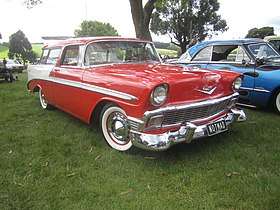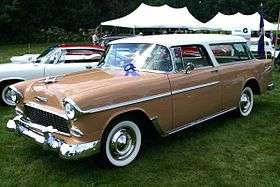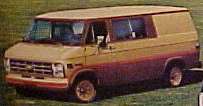Chevrolet Nomad
The Chevrolet Nomad is a station wagon model produced by Chevrolet that was marketed from 1955 to 1961, from 1967 to 1972, and then used as a trim package on the 1976 Vega as well as for Chevrolet vans during the late 1970s and early 1980s.
| Chevrolet Nomad | |
|---|---|
 1956 Chevrolet Bel Air Nomad | |
| Overview | |
| Manufacturer | Chevrolet (General Motors) |
| Production | 1955–1961 1968–1972 |
| Layout | FR layout |
In South Africa, the Nomad name was used on a small utility vehicle.
The Nomad is best remembered in its two-door Tri-Five form that was considered a halo model during its three-year production. It was named for nomads.
The resourceful crime-fighter, activist, and action-hero Angus MacGyver drives a teal-blue '57 Chevy Nomad with white roof and trim-accents during some of his episodes; like his 1946 beige-and-brown Chevy pickup, this car was left to him by his late grandfather, Harry Jackson.
Pre production
The two-door Nomad differed from other station wagons of the era by having unique styling more reminiscent of a hardtop sedan than that of a standard station wagon. Chevrolet shared this body with Pontiac, which marketed its version as the Pontiac Safari.
The Nomad's unique design had its roots in a General Motors Motorama show car of the same name that was shared with the Corvette, Pontiac Bonneville Special, and the Oldsmobile F-88. The Concept was introduced at the GM Motorama in 1954 as one of Head Stylist Harley Earl's "dream cars". It followed the introduction in 1950 of the Ford Country Squire two-door station wagon.
GM approved production of the vehicle if the design could be transferred to its standard model because top GM brass felt that they could sell more models if it were attached to the popular Bel Air model. Following the product debut in 1955, it was not uncommon for the car to be referred to as the Chevy "Bel Air Nomad".
First generation: 1955–1957
| First generation | |
|---|---|
 | |
| Overview | |
| Production | 1955–1957 |
| Body and chassis | |
| Body style | 2-door station wagon (1955–1957) |
| Platform | A-body |
| Powertrain | |
| Engine | 265 cu in (4.3 L) V8 283 cu in (4.6 L) V8 |
| Dimensions | |
| Wheelbase | 115 in (2,921.0 mm)[1] |
| Length | 201 in (5,105.4 mm)[2] |
- 1955 Chevrolets received all-new styling. Advertised as "The Hot One," the boxy new Chevy was crisp, clean, and thoroughly modern-looking, and its popularity was shared with the Tri-Five Chevrolets of this generation. Nomads, like Bel Airs, came loaded with interior carpet, chrome spears on front fenders, chrome window moldings, and full wheel covers. For 1955, Chevrolets gained a V8 engine option. The new 265 cu in (4.3 L) V8 featured a modern, overhead valve, high compression, short stroke design that was so good that it remained in production in various forms for many decades. The base V8 had a two-barrel carburetor and was rated at 162 hp (121 kW), and the "Power Pack" option featured a four-barrel carburetor and other upgrades yielding 180 bhp (134 kW). Later in the year, a "Super Power Pack" option added high-compression and a further 15 bhp (11 kW). It had room for six passengers.[3]
- 1956 Chevrolets received a face-lift. This gave Chevys a more conventional full-width grille, pleasing those customers who did not like the 1955 front end. Nomads now carried the same interior and rear-wheel sheet metal as other Bel Airs, lacking the original's unique trim. A padded dashboard was now available. For 1956 Chevy hid the gas cap behind a flip-down tail light on the left side.
- 1957 V-8 engine displacement grew to 283 cu in (4.6 L) from 265 in 1957, with the "Super Turbo Fire V8" option producing 283 hp (211 kW) with a fuel injection system. The vast majority of cars had engines with carburetors. While considered to be a milestone vehicle design, General Motors discontinued the original Nomad Sport Wagon at the end of the 1957 model year due to low sales and the introduction of a new body for 1958.
Second generation: 1958–1961
| Second generation | |
|---|---|
 | |
| Overview | |
| Production | 1958–1961 |
| Body and chassis | |
| Body style | 4-door station wagon |
| Platform | GM B platform |
| Powertrain | |
| Engine | 265 cu in (4.3 L) V8 283 cu in (4.6 L) V8 |
- 1958 For the 1958 model year, Chevrolet moved the Nomad name to its top-line four-door Bel Air-based station wagon,[4] right above the new mid-priced Biscayne based Brookwood. This was the only four-door Bel Air-based Nomad station wagon. Like the rest of Chevrolet's 1958 full-size car line up, the Nomad featured Chevrolet's new "Safety-Girder" cruciform frame. Similar in layout to the frame adapted for the 1957 Cadillac, it featured box-section side rails and a boxed front cross member that bowed under the engine, these "x-frames" were used on other 1958 to 1964 Chevys, as well as Cadillac. The rear was tied together by a channel-section cross member.[5]
- 1959 In 1959, the Nomad was transferred from the Bel Air to the expanded Impala model range, which had been the top-line Chevrolet two-door hardtop and convertible the previous year; Impala now became a separate model that included four-door cars. Nomad, still at the top was a six-passenger car. The other 1959 Chevrolet station wagons were the new Kingswood four-door, nine-passenger, the new Parkwood four-door six-passenger, the new Brookwood two-door six passengers, and Brookwood four-door six Passenger. With the Delray gone, the Biscayne-based Brookwood was now priced lowest. The Brookwood two-door marked the short-lived return of the two-door wagon and was the basis for the new-for-1959 El Camino. The El Camino carried mid-level Parkwood (Bel Air) exterior trim, with Brookwood (Biscayne) interior.
- 1960 For 1960, the Impala-based Nomad four-door was revised with more conventional styling. The Kingswood and the two-door Brookwood were dropped at the end of the year along with the El Camino.
- 1961 In 1961, all full-size Chevrolets were restyled on the existing GM B platform. The new body styling was more trim and boxy than the 1958-60 models. Chevrolet continued to use the Nomad name until the end of the 1961 model year when all Chevrolet station wagons adopted the names of the regular sedan models for 1962. The Nomad had body-on-frame construction, using the "X" frame to the end.
Third generation: 1968–1972
| Third generation | |
|---|---|
 | |
| Overview | |
| Production | 1968–1972 |
| Body and chassis | |
| Body style | 4-door station wagon |
| Platform | GM A platform (RWD) |
Between 1968 and 1972 the names Nomad and Nomad Custom were applied to the lowest-priced Chevelle four-door station wagon model, below the Chevelle Greenbrier, Chevelle Concours, and Chevelle Concours Estate.
- 1968 For 1968, Chevelle got a new body style (though still under the 817 and 817 internal designations) emphasized the "Coke bottle" look even more. New Federal safety-mandated equipment included side marker lights on each fender, as well as shoulder belts for outboard front seat occupants on cars built after December 1, 1967. This explains why some '68s had shoulder belts, and some early-production cars did not. However, all '68s had anchored for the belts. Manual transmission cars got GM's "Air Injection Reactor (A.I.R)" smog pump, which added complexity under the hood.
- 1969 By 1969, each Chevrolet station wagon regained its own unique model name. All '69 Chevelles also got a new locking steering column, one year ahead of the Federal requirement. Headrests, required for all cars sold in the U.S. after January 1, 1969, were installed on all '69 GM cars.
- 1970 The 1970 Chevelle Nomad had even more restyling. Each head lamp was put in its own chrome housing and was no longer integrating into the grille. The body lines were less swept and a new integrated rear bumper was used.
- 1971 For 1971, all Chevelles got two big headlights in place of the quads, and GM mandated all divisions design their engines to run on lower-octane regular, low-lead or unleaded gasoline due to tightening emission requirements and in anticipation of the catalytic converter that would be used on 1975 and later models, necessitating the use of unleaded fuel. To permit usage of the lower-octane fuels, all engines featured low compression ratios (9:1 and lower; well below the 10.25-11.25:1 range on high-performance engines of 1970 and earlier).
- 1972 The last Nomad station wagon ended with the end of the second-generation Chevelle at the end of the 1972 model year.
1976 Chevy Vega wagon Nomad package
In 1976, special Vega Nomad wagons were assembled with unique side window trim and filler panels (to make the 'b' pillars appear forward-slanted), tailgate rub strips, vinyl Nomad script identification.
Chevy Van Nomad

In the late 1970s and early 1980s, the name returned again on a trim package for the full-size G20 Chevrolet Van with 125 in (3,175 mm) wheelbase.[6] It featured five-passenger seating with swiveling captain seats up front, a bench in the middle, and a spacious cargo area in the rear with no quarter windows. It could be had with plaid upholstery and two-tone paint.[7]
It was offered along with Sportvan, CaraVan, Commercial Van, and Cube Van.
South African Chevrolet Nomad
In South Africa, a small utility vehicle called the Chevrolet Nomad appeared in 1976. To save development costs and to keep the price low, the ladder-framed vehicle was only available with rear-wheel drive and a locally built 2.5-liter cast-iron inline-four engine, also of Chevrolet origins. Nonetheless, a combination of ample ground clearance, a short wheelbase, and light-weight, meant that off-road capabilities remained respectable.[8] The wheelbase is 2,083 mm (82.0 in), and the ground clearance 265 mm (10.4 in). It also has a sump guard and a sturdy steel box-section grille to protect the radiator and headlamps.[9] The Nomad was only available with an open two-door body, with a folding front window and an available soft-top or fiber-glass hardtop. The design was simple, entirely of flat panels designed for ease of construction and to enable local parts content to be maximized - at 82 percent it was the highest achieved yet in South Africa.[10]
The engine, also used in the Chevrolet 2500 as well as a host of other local GM products, was tuned down for improved lower-end torque. Now fitted with a Rochester carburetor it produces 67 kW (91 PS; 90 hp) at 4000 rpm, enough for a top speed of 134.8 km/h (84 mph) in a period test.[10] The front suspension proved weak, however, and by the time Chevrolet had redesigned it buyer resistance had already doomed the Nomad.
Concept cars


Chevrolet produced several Nomad concept cars:
1954: Chevrolet Corvette Nomad was Harley Earl's Corvette-based concept introduced at the GM Motorama. It made its debut along with the 1954 Corvette Hardtop and 1954 Corvette Corvair. It is believed the car was crushed by GM after the event, although replicas exist.
1979: The front-wheel-drive Chevrolet Nomad II minivan concept, based on GM's X-platform, several years before the Dodge Caravan and Renault Espace. It received strong approval from the customer clinics, but General Motors decided to not produce it.[11]
1999: Another Nomad concept was based on the first generation Camaro, powered by a V8.[12]
2004: Another concept was based on the GM Kappa platform and resembled the 1954 Corvette-based Nomad show car.[13][14] It had a 107-inch wheelbase and was 155.5 inches long.[15]
See also
- Chevrolet 150
- Chevrolet 210
- Ford Del Rio, direct competition to the Nomad (1957-58)
References
- https://auto.howstuffworks.com/1955-1957-chevrolet-nomad2.htm
- "1957 Chevrolet Owners Manual". Oldcarbrochures.com. Retrieved 2011-11-20.
- "1957 Chevrolet brochure 1". Oldcarbrochures.com. Retrieved 2011-11-20.
- "1958 Chevrolet Wagons brochure". Oldcarbrochures.com. pp. 2–3. Retrieved 2011-11-20.
- "1958 Chevrolet Wagons brochure". Oldcarbrochures.com. pp. 6–7. Retrieved 2011-11-20.
- "1977 Chevrolet Vans brochure". Old Car Brochures Project. p. 6. Retrieved 10 June 2020.
- "1979 Chevrolet Nomad Van - Auburn Spring 2018". RM Sotheby's. May 2018. Retrieved 10 June 2020.
- Howard, Tony (October 1976). "Chevrolet Nomad". SA Motor. Cape Town, South Africa: Scott Publications: 29.
- Howard, p. 31
- Howard, pp. 33-34
- "1979 Chevrolet Nomad Concept Poster". GM Photo Store.
- "1999 Chevrolet Nomad Concept". seriouswheels.com (Press release). Retrieved 12 November 2019.
- "Chevy Nomad concept recalls 1954 Nomad". Canadian Driver. 4 January 2004. Retrieved 12 November 2019.
- "Chevrolet Nomad, 2004". madle.org. Retrieved 12 November 2019.
- Newberry, Stephan (2005). The Car design yearbook 3. Merrell. ISBN 1-85894-242-X.
Further reading
| Wikimedia Commons has media related to Chevrolet Nomad. |
- Gunnell, John, Editor (1987). The Standard Catalog of American Cars 1946-1975. Krause Publications. ISBN 0-87341-096-3.CS1 maint: multiple names: authors list (link)
- Dammann, George H. (1986). 75 Years of Chevrolet. Motorbooks International(Crestline Series). ISBN 0-87938-692-4.
- "Chevrolet Nomad." Pictures and Information on oldride.com.